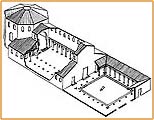|
The Holy Land: Bethlehem
The Nativity Church in Bethlehem was, along with
the C hurch
of the Holy Sepulcher in Jerusalem, another landmark for Christian
pilgrimage. It was begun by
Constantine I
(326), and rebuilt by Justinian (after 560). The Constantinian
building consisted of three main parts disposed axially: a
large
atrium; a five-aisled
square
basilica (26,5x26,5
m); and the
martyrion
proper, an octagon built over the Grotto of the Nativity.
Within the latter was a smaller octagonal platform with a
large circular opening, through which worshippers could gaze
into the cave. The plan, a basilica intended for the meeting
of believers, and an octagon containing the holy shrine, recalls
the monumental mausoleums of the Roman emperors. The Church
of the Holy Sepulcher in Jerusalem is basically of the same
type, although an enclosed court separated the basilica from
the shrine. When Justinian decided to restore the Nativity
Church, he sent over a first architect, but is said to have
rejected his work and had him beheaded. Initial plans to raise
a dome over the octagon failed, because of the building's
great proportions. The octagon was replaced altogether by
a cloverleaf triple
apse; the basilica
and atrium were lengthened and a
narthex created
between the two. Justinian's builders used the columns and
capitals of the old church and added ten new columns and four
corner columns. A north and south entrance, shut by heavy
bronze doors, led to the Grotto. hurch
of the Holy Sepulcher in Jerusalem, another landmark for Christian
pilgrimage. It was begun by
Constantine I
(326), and rebuilt by Justinian (after 560). The Constantinian
building consisted of three main parts disposed axially: a
large
atrium; a five-aisled
square
basilica (26,5x26,5
m); and the
martyrion
proper, an octagon built over the Grotto of the Nativity.
Within the latter was a smaller octagonal platform with a
large circular opening, through which worshippers could gaze
into the cave. The plan, a basilica intended for the meeting
of believers, and an octagon containing the holy shrine, recalls
the monumental mausoleums of the Roman emperors. The Church
of the Holy Sepulcher in Jerusalem is basically of the same
type, although an enclosed court separated the basilica from
the shrine. When Justinian decided to restore the Nativity
Church, he sent over a first architect, but is said to have
rejected his work and had him beheaded. Initial plans to raise
a dome over the octagon failed, because of the building's
great proportions. The octagon was replaced altogether by
a cloverleaf triple
apse; the basilica
and atrium were lengthened and a
narthex created
between the two. Justinian's builders used the columns and
capitals of the old church and added ten new columns and four
corner columns. A north and south entrance, shut by heavy
bronze doors, led to the Grotto.
|